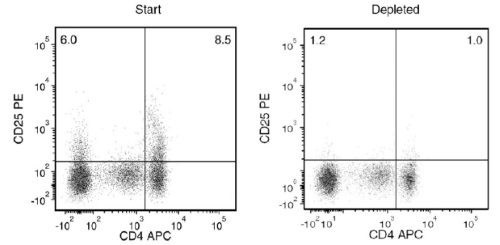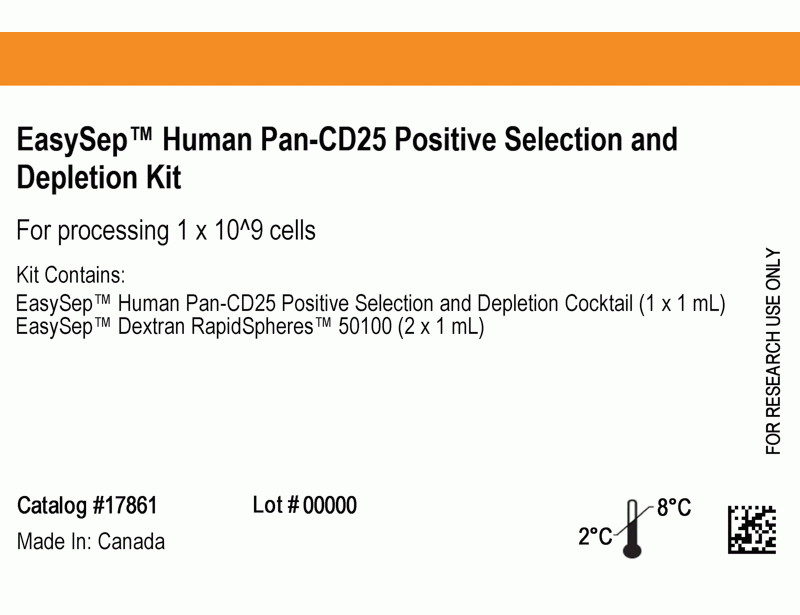EasySep™ Human Pan-CD25 Positive Selection and Depletion Kit
Immunomagnetic positive selection cell isolation kit
概要
The EasySep™ Human Pan-CD25 Positive Selection and Depletion Kit is designed to deplete CD25+ cells from fresh peripheral blood mononuclear cells or lysed leukapheresis samples. CD25+ cells are targeted with Tetrameric Antibody Complexes recognizing CD25 and dextran-coated magnetic particles. Labeled cells are separated using an EasySep™ magnet without the use of columns. Labeled cells remain in the tube while unlabeled cells are poured off. The CD25 antigen is expressed on regulatory T cells and activated T and B cells.
Advantages
• Fast, easy-to-use and column-free
• Up to 1.3 log depletion of CD25+ cells
• Up to 98% purity
• Up to 1.3 log depletion of CD25+ cells
• Up to 98% purity
Components
EasySep™ Human Pan-CD25 Positive Selection and Depletion Kit (Catalog #17861)
- EasySep™ Human Pan-CD25 Positive Selection and Depletion Cocktail, 1 mL
- EasySep™ Dextran RapidSpheres™ 50100, 2 x 1 mL
Magnet Compatibility
• EasySep™ Magnet (Catalog #18000)
• “The Big Easy” EasySep™ Magnet (Catalog #18001)
Subtype
Cell Isolation Kits
Cell Type
T Cells, T Cells, CD4+, T Cells, Regulatory
Species
Human
Sample Source
PBMC
Selection Method
Depletion
Application
Cell Isolation
Brand
EasySep
Area of Interest
Immunology
技术资料
| Document Type | 产品名称 | Catalog # | Lot # | 语言 |
|---|---|---|---|---|
| Product Information Sheet | EasySep™ Human Pan-CD25 Positive Selection and Depletion Kit | 17861 | All | English |
| Safety Data Sheet | EasySep™ Human Pan-CD25 Positive Selection and Depletion Kit | 17861 | All | English |
数据及文献
Data

Starting with fresh PBMCs, the CD25+ cell content of the depleted fraction typically ranges from 2 - 5%. In the above example, the purities of the start and final depleted fractions are 14.5% and 2.2%, respectively, with a 1.3 log depletion of CD25+ cells. Using the optional positive selection protocol, the CD25+ cell content of the isolated fraction typically ranges from 81 - 98% (data not shown).
Publications (2)
Acta neuropathologica communications 2017 dec
CRISPR/Cas9-Correctable mutation-related molecular and physiological phenotypes in iPSC-derived Alzheimer's PSEN2 N141I neurons.
Abstract
Abstract
Basal forebrain cholinergic neurons (BFCNs) are believed to be one of the first cell types to be affected in all forms of AD, and their dysfunction is clinically correlated with impaired short-term memory formation and retrieval. We present an optimized in vitro protocol to generate human BFCNs from iPSCs, using cell lines from presenilin 2 (PSEN2) mutation carriers and controls. As expected, cell lines harboring the PSEN2 N141I mutation displayed an increase in the A$\beta$42/40 in iPSC-derived BFCNs. Neurons derived from PSEN2 N141I lines generated fewer maximum number of spikes in response to a square depolarizing current injection. The height of the first action potential at rheobase current injection was also significantly decreased in PSEN2 N141I BFCNs. CRISPR/Cas9 correction of the PSEN2 point mutation abolished the electrophysiological deficit, restoring both the maximal number of spikes and spike height to the levels recorded in controls. Increased A$\beta$42/40 was also normalized following CRISPR/Cas-mediated correction of the PSEN2 N141I mutation. The genome editing data confirms the robust consistency of mutation-related changes in A$\beta$42/40 ratio while also showing a PSEN2-mutation-related alteration in electrophysiology.
Scientific reports 2017 AUG
Combinations of isoform-targeted histone deacetylase inhibitors and bryostatin analogues display remarkable potency to activate latent HIV without global T-cell activation.
Abstract
Abstract
Current antiretroviral therapy (ART) for HIV/AIDS slows disease progression by reducing viral loads and increasing CD4 counts. Yet ART is not curative due to the persistence of CD4+ T-cell proviral reservoirs that chronically resupply active virus. Elimination of these reservoirs through the administration of synergistic combinations of latency reversing agents (LRAs), such as histone deacetylase (HDAC) inhibitors and protein kinase C (PKC) modulators, provides a promising strategy to reduce if not eradicate the viral reservoir. Here, we demonstrate that largazole and its analogues are isoform-targeted histone deacetylase inhibitors and potent LRAs. Significantly, these isoform-targeted HDAC inhibitors synergize with PKC modulators, namely bryostatin-1 analogues (bryologs). Implementation of this unprecedented LRA combination induces HIV-1 reactivation to unparalleled levels and avoids global T-cell activation within resting CD4+ T-cells.


